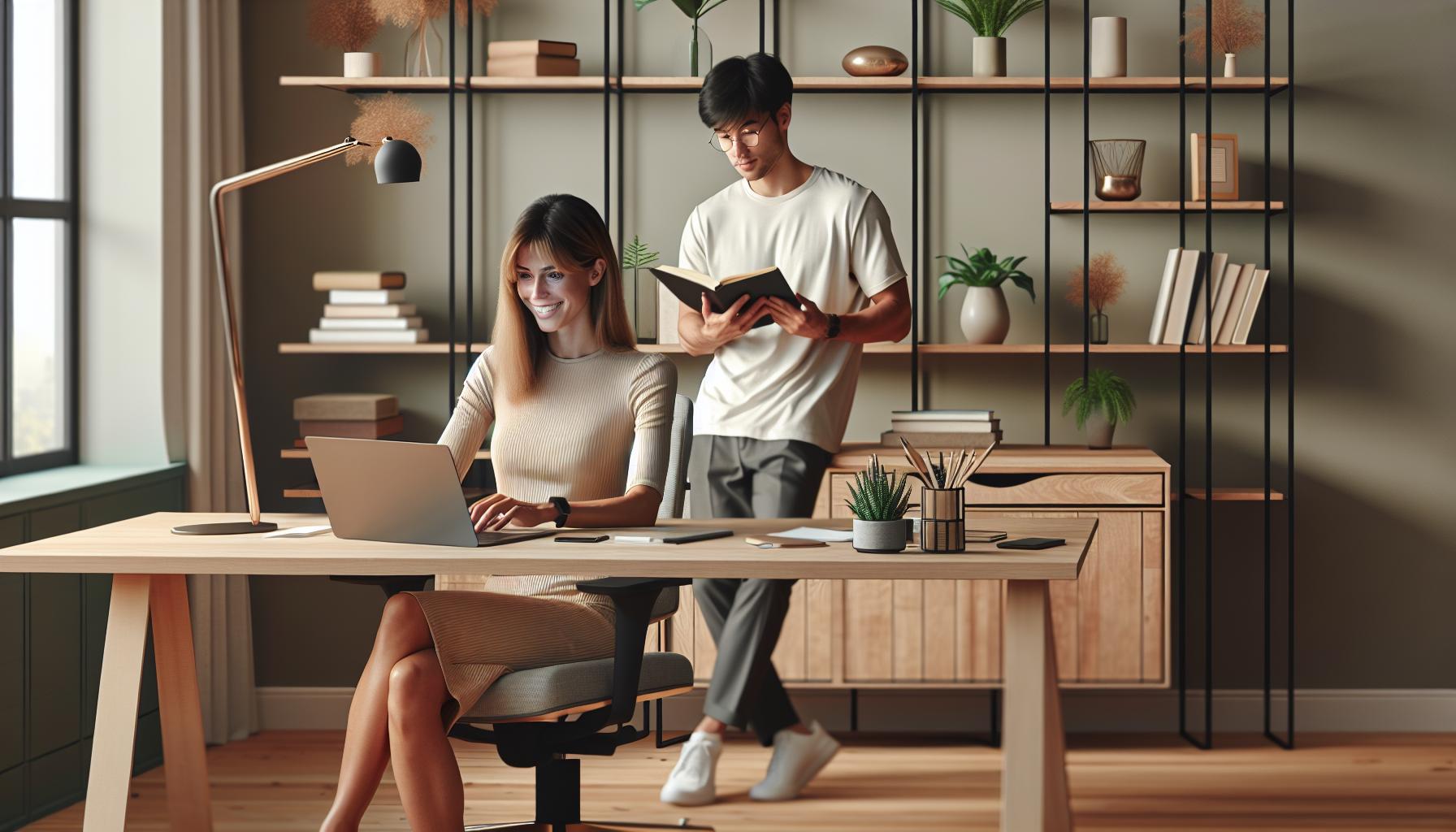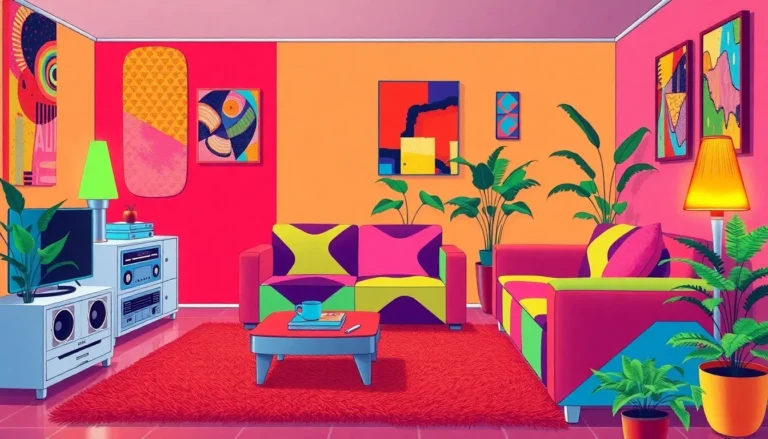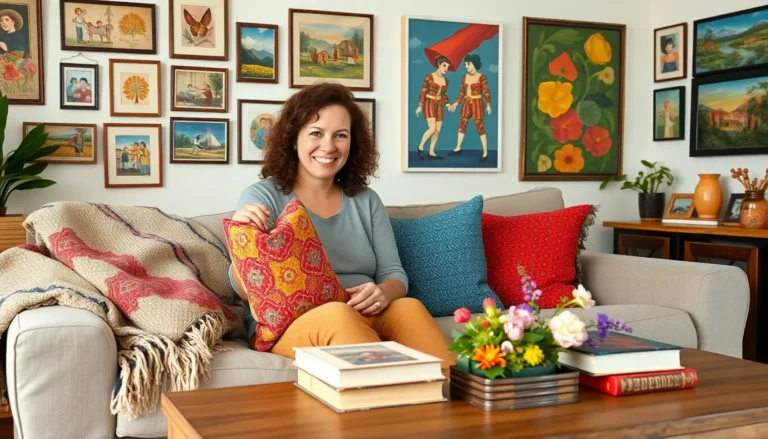Working from home can be a challenge, especially when you’re sharing the space with someone else. I know firsthand how important it is to create a harmonious and efficient home office that caters to both your needs. Finding the right balance between comfort and productivity is key, and with a few clever ideas, you can transform any corner of your home into a collaborative workspace.
Key Takeaways
- Separate Work Zones: Create distinct areas for each person to enhance focus and personalization while minimizing distractions.
- Shared Desk Solutions: Choose a spacious, organized desk that accommodates both individuals, incorporating built-in storage to keep supplies accessible.
- Ergonomic Setup: Invest in ergonomic chairs and adjustable desks to promote comfort and productivity during long work hours.
- Efficient Storage: Use smart storage solutions like vertical shelving and under-desk organizers to reduce clutter and maintain an orderly workspace.
- Mood-Enhancing Decor: Incorporate elements like plants and artwork to foster a positive atmosphere, while maximizing natural light for improved concentration.
- Flexible Layout: Design a flexible workspace that allows for periodic rearrangement, keeping the environment fresh and adaptable to changing needs.
Home Office Ideas For Two
Creating a functional and aesthetically pleasing home office for two requires thoughtful planning. I focus on several innovative ideas that enhance productivity and comfort.
Separate Work Zones
Establish distinct work areas for each person. This separation minimizes distractions and allows for personalized setups. For instance, I often divide the space using bookcases or movable partitions, ensuring each person has their own functional zone.
Shared Desk Solutions
Invest in a spacious, shared desk. A long table accommodates two laptops, allowing both individuals to work side by side. I suggest selecting desks with built-in storage to keep supplies organized and accessible.
Ergonomic Seating
Choose ergonomic chairs that offer comfort for long hours of work. I recommend adjustable options that fit individual preferences. Pairing ergonomic seating with supportive cushions boosts productivity and wellbeing.
Efficient Storage
Implement smart storage solutions to reduce clutter. Use vertical shelving units and under-desk storage to maximize space. I find labeled bins and drawers helpful in keeping documents and office supplies organized.
Mood-Enhancing Decor
Incorporate decor that fosters a positive work atmosphere. I often add plants, artwork, or ambient lighting to create an inviting space. Natural light also significantly enhances mood and concentration.
Technology Integration
Integrate technology effectively by utilizing cable organizers and wireless devices. This minimizes visual clutter and enhances the workspace’s functionality. I recommend using a single power strip for easier access to outlets.
Flexible Layout
Adopt a flexible layout that accommodates changes. I often rearrange furniture periodically to keep the space fresh. Modular furniture can adapt to varying work arrangements and preferences.
Communication Tools
Utilize communication tools that enhance collaboration. I recommend shared calendars, project management apps, or messaging platforms. These tools streamline communication and ensure both individuals stay aligned.
Implementing these ideas can transform any home office into an efficient and harmonious workspace for two people.
Space Planning
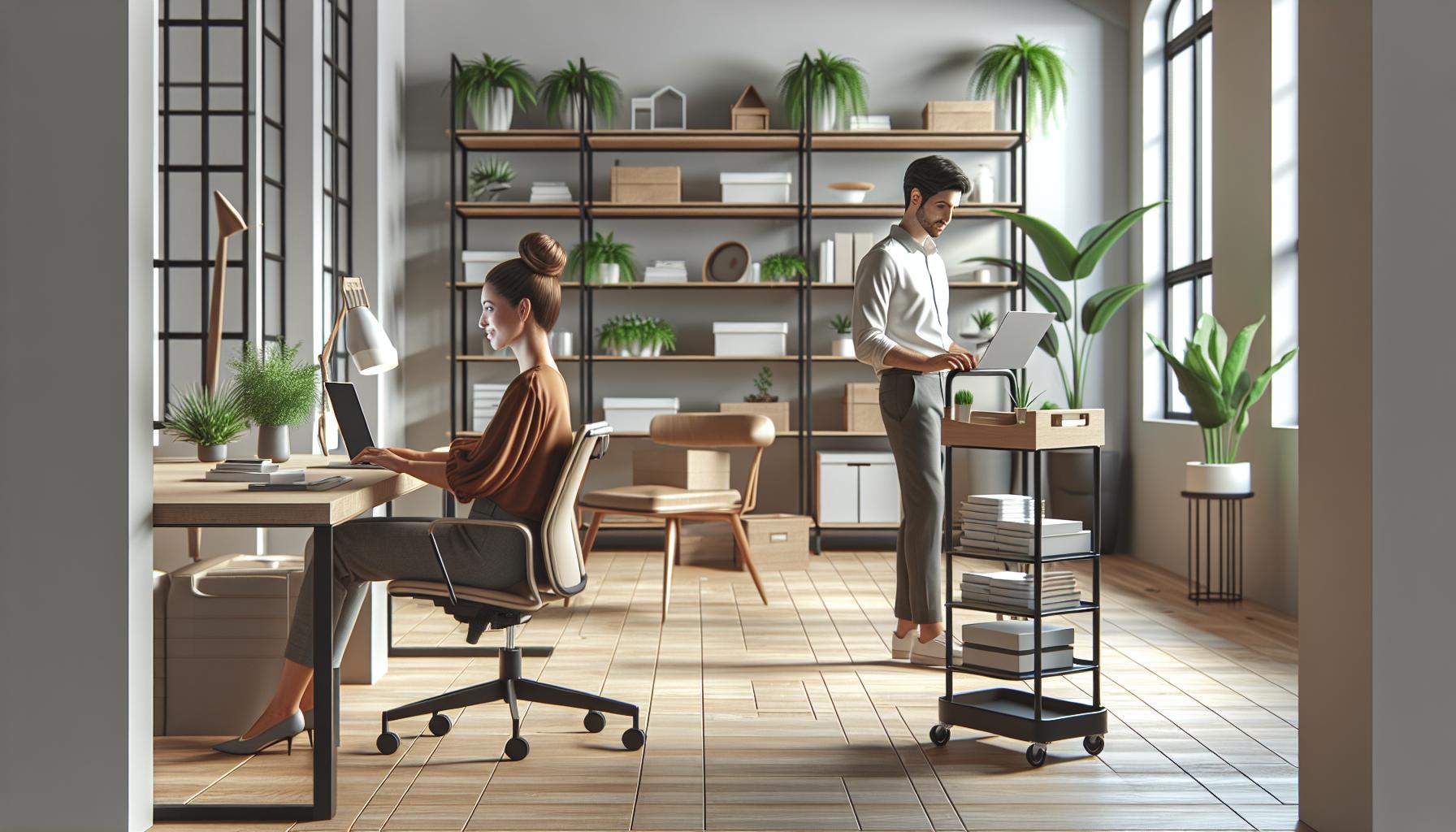
Effective space planning ensures that both individuals can work productively while sharing the home office. By optimizing shared spaces and creating separate zones, the workspace fosters collaboration and efficiency.
Optimizing Shared Spaces
Optimizing shared spaces involves selecting multifunctional furniture and smart storage solutions. Choosing a large desk that accommodates both individuals provides ample workspace while minimizing clutter. Incorporating vertical storage, such as wall shelves and pegboards, maximizes floor space. Additionally, using mobile carts for supplies offers flexibility and easy access. Integrating plants or artwork can enhance aesthetics, promoting a positive work environment.
Creating Separate Zones
Creating separate zones helps maintain focus and reduce distractions. I can designate specific areas for each person, perhaps by using room dividers or bookshelves. This arrangement establishes boundaries while maintaining an open feel. Each zone should include personal touches, like individual decor or color schemes, to foster a sense of ownership. Ensuring that desk setups feature ergonomic chairs and adequate lighting promotes comfort and productivity. A clear plan for equipment, such as printers or filing cabinets, ensures both users have convenient access without overcrowding the space.
Furniture Selection
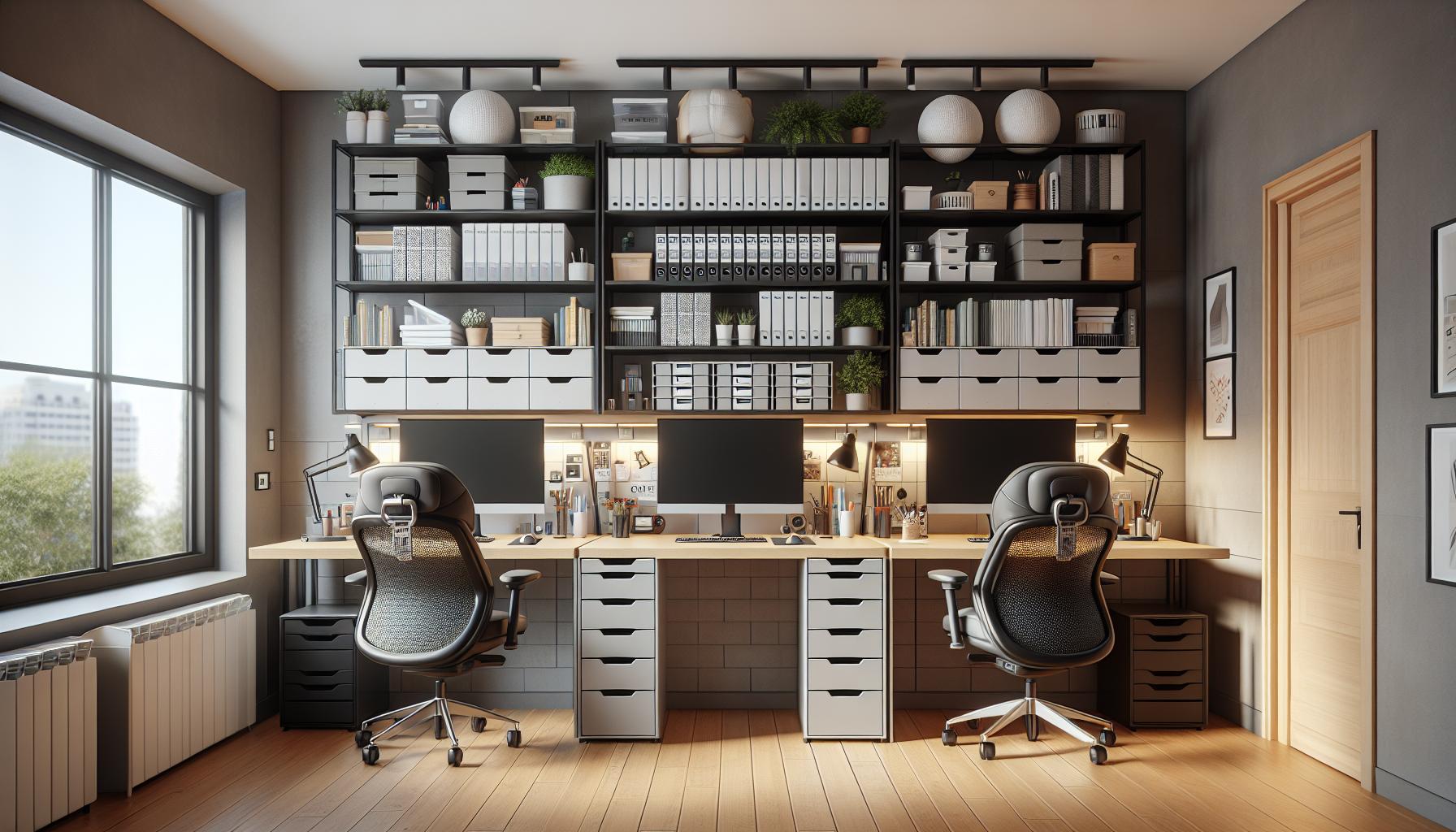
Selecting the right furniture plays a crucial role in creating an efficient home office for two. Thoughtfully chosen pieces can enhance comfort, productivity, and harmony in the shared workspace.
Desks and Chairs
Choosing the right desks and chairs can significantly affect productivity and comfort. Opt for a large shared desk that provides ample space for both individuals, ensuring that it’s at least 60 inches wide to accommodate dual monitors and workspace essentials. Consider height-adjustable desks for flexibility, allowing both of us to alternate between sitting and standing throughout the day, which promotes better posture and reduces fatigue.
Select ergonomic chairs with adjustable features to fit each user’s height and preference. Look for chairs with lumbar support to maintain a healthy posture during long hours of work. A chair’s mobility matters, so invest in options with wheels and five-point bases for easy movement.
Storage Solutions
Effective storage solutions minimize clutter and enhance organization. Use vertical shelving units to maximize wall space while keeping frequently accessed items within reach. Aim for at least 24 inches of shelf depth for stamina and durability.
Incorporate drawer units and filing cabinets placed under the desk to maintain a clean workspace. Opt for divided organizers inside drawers to separate office supplies, papers, and tech accessories. Consider labeled bins or baskets on shelves to streamline organization—clear or open containers help to see contents quickly.
Choose furniture that serves dual purposes, such as ottomans with storage or desks equipped with built-in shelves. These multifunctional pieces save space and promote an efficient work environment.
Decor and Personalization
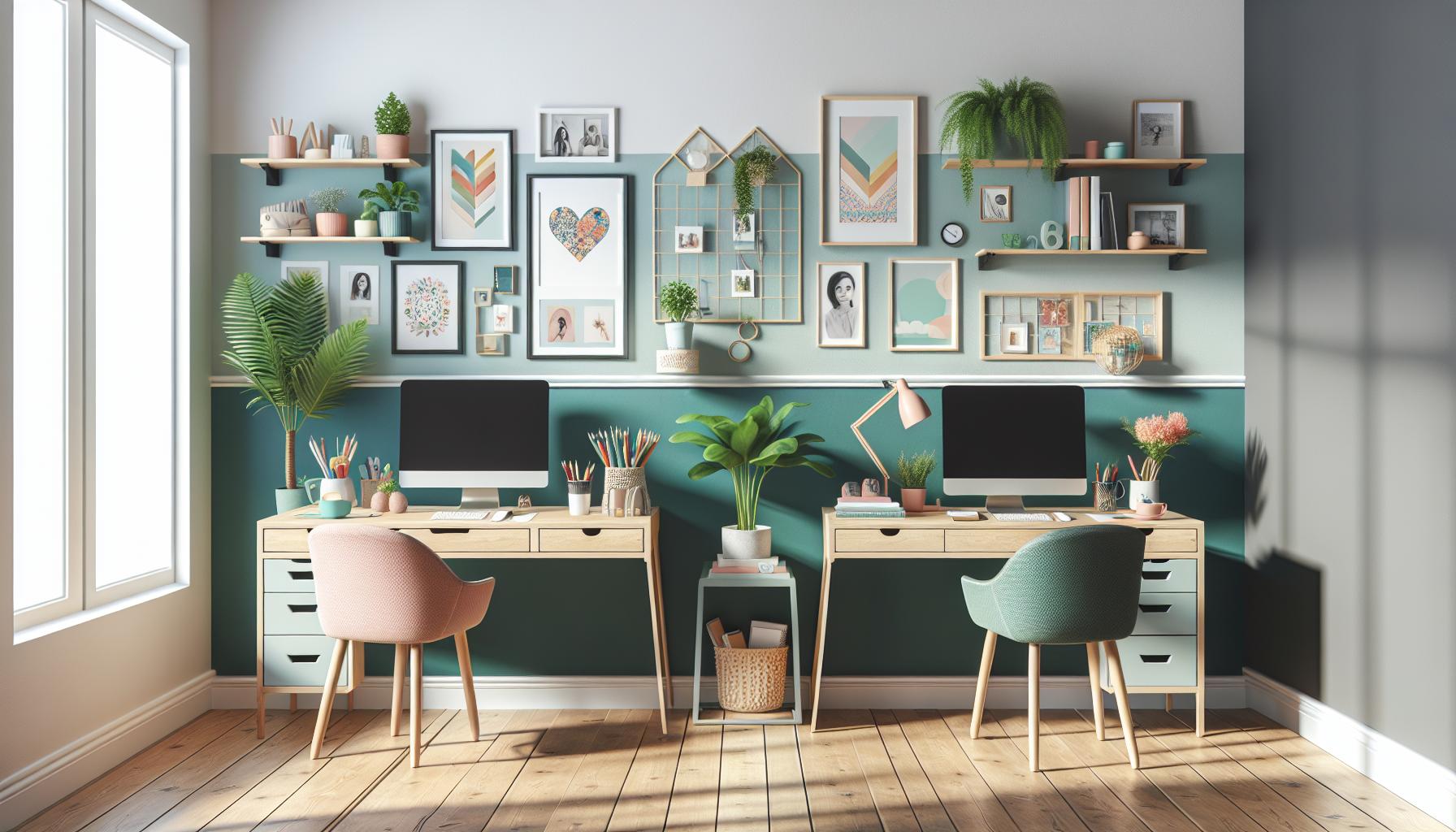
Creating a personalized workspace enhances both comfort and productivity. Thoughtful decor choices and color schemes can transform a shared office into a motivating environment.
Color Schemes
I recommend using harmonious color schemes to promote focus and creativity. Neutral colors like greys or beiges create a calming backdrop, while pops of brighter colors, like teal or mustard, can energize the space. A balanced approach works best—often, a 60-30-10 ratio helps: 60% neutral base, 30% secondary color, and 10% accent color. For instance, painting one wall in a bold color can serve as a focal point without overwhelming the room. Utilize colorful accessories like desk organizers or artwork that resonates with both individuals’ personalities.
Adding Personal Touches
Incorporating personal elements fosters a sense of belonging. Displaying framed photos, motivational quotes, or artwork enhances the atmosphere of the workspace. Shared plants or succulents add greenery while improving air quality—easy maintenance suits busy schedules. A curated selection of books or decorative items on shelves can reflect both individuals’ interests and inspire creativity. Customizing each workspace zone with unique decor allows for personal expression while maintaining a cohesive aesthetic throughout the office.
Productivity Tips
Creating a productive environment in a shared home office requires thoughtful planning. Here are some effective strategies to enhance focus and cooperation.
Minimizing Distractions
Minimizing distractions significantly boosts productivity in a shared workspace. Implement these strategies:
- Establish Clear Boundaries: Define personal zones within the office to reduce interruptions.
- Use Noise-Canceling Headphones: Noise-canceling headphones block out distractions from ambient sounds, enhancing concentration.
- Set Ground Rules: Agree on noise levels and acceptable break times to create a more serene atmosphere.
- Limit Device Interruptions: Turn off notifications on smartphones and computers during designated work hours.
- Optimize Layout: Position workspaces away from high-traffic areas in the home to minimize distractions.
- Create a Shared Calendar: A shared calendar helps synchronize schedules and manage commitments efficiently.
- Set Core Hours: Define overlapping work hours for collaborative projects, ensuring both individuals are present.
- Allocate Break Times: Plan regular breaks to recharge without interfering with each other’s workflow.
- Allow Flexibility: Allow for adjustments to accommodate personal commitments or shifts in workload.
- Communicate Changes: Inform each other promptly about any schedule changes to maintain clarity and cooperation.
Conclusion
Creating a home office for two can be a rewarding experience when done right. By prioritizing comfort and productivity I can transform any space into an efficient workspace that caters to both of our needs.
Focusing on effective space planning and utilizing multifunctional furniture helps minimize clutter while enhancing collaboration. Personal touches and a harmonious color scheme not only boost motivation but also foster a sense of belonging.
With the right strategies in place I can ensure that both of us stay focused and productive. Embracing flexibility and open communication will make our shared workspace a place where we can thrive together.

